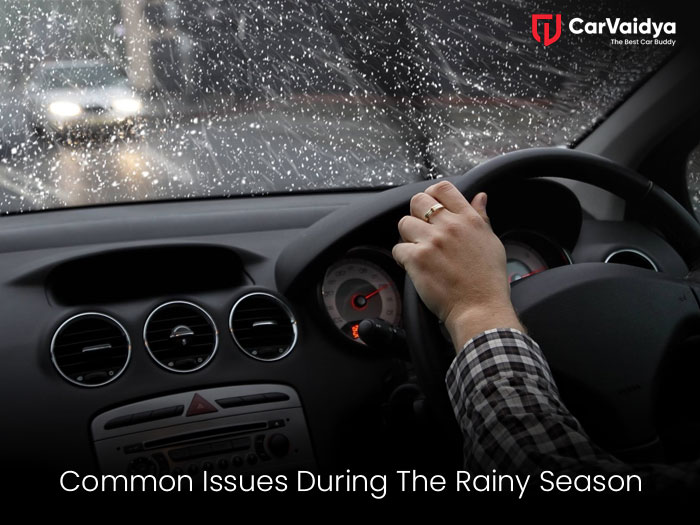The rainy season can be especially challenging for car owners. As rainwater seeps into various parts of the vehicle, it can lead to several mechanical and electrical issues. response these trouble proactively can save a lot of time and money. Here's a thorough look at common issues cars face during the rainy season:
1. Hydroplaning
Hydroplaning occurs when a layer of water builds up between the tires and the road surface, leading to a loss of traction. This can cause the vehicle to skid uncontrollably. Hydroplaning is particularly dangerous because it significantly reduces the driver's ability to steer or brake, increasing the risk of accidents.
Prevention Tips
- Ensure your tires have sufficient tread depth.
- Reduce speed during heavy rains.
- Avoid sudden turns and braking.
2. Electrical System Issues
Water and electricity are a perilous combo. During the rainy season, water can pervade electrical entrails, leading to short circuits and electrical failures. Commonly affected parts include the battery, alternator, and wiring.
Prevention Tips
- Regularly check for any exposed or damaged wiring.
- Ensure that the battery terminals are clean and tightly connected.
- Consider using dielectric grease on electrical connections to prevent moisture ingress.
3. Braking Problems
Wet conditions can affect the braking system's efficiency. Water on brake pads and discs can reduce friction, leading to longer stopping distances. In extreme cases, water can cause brake fade, where the brakes become less effective after prolonged use.
Prevention Tips
- Replace brake pads and discs regularly.
- Ensure that the braking system is properly maintained and checked for wear.
- Drive at reduced speeds and maintain a safe following distance.
4. Visibility Issues
Rain can significantly reduce visibility, making it harder for drivers to see the road and other vehicles. Fogged-up windows and ineffective wipers can exacerbate the problem, increasing the risk of accidents.
Prevention Tips
- Ensure windshield wipers are in good condition and replace them if they are worn out.
- Use a high-quality windshield washer fluid.
- Keep windows clean and use anti-fogging solutions.
5. Flooding and Water Damage
Driving through flooded areas can cause severe damage to a vehicle. Water can enter the engine, transmission, and other critical components, leading to costly repairs. Additionally, interior flooding can damage the upholstery and electronics inside the car.
Prevention Tips
- Avoid driving through flooded roads. If necessary, find an alternate route.
- If caught in a flood, avoid starting the engine until a professional can inspect the vehicle.
- Use waterproof covers for seats and floor mats to protect the interior.
6. Tire Problems
Wet roads reduce tire grip, which can lead to skidding and reduced control. Additionally, under-inflated or worn-out tires are more receptive to punctures and blowouts during the rainy season.
Prevention Tips
- Regularly check tire pressure and maintain it at the recommended level.
- Inspect tires for wear and replace them if necessary.
- Consider using tires designed for wet conditions.
7. Rust and Corrosion
Excess moisture can advance rust and erosion on various parts of the vehicle, including the undercarriage, exhaust system, and body panels. This can weaken the anatomical integrity of the car and lead to costly repairs.
Prevention Tips
- Regularly wash and wax your car to create a protective barrier against moisture.
- Apply rust-proofing treatments to vulnerable areas.
- Keep the undercarriage clean and free of debris.
8. Engine Stalling
Water entering the engine bay can lead to stalling. This is especially common when driving over deep puddles or flooded streets. Water can disrupt the engine's air intake, fuel system, or electrical entrails, causing it to shut down.
Prevention Tips
- Avoid driving through deep water.
- Ensure the engine bay is properly sealed and free of leaks.
- Have the air intake and other critical components checked regularly.
9. Lighting and Signal Failures
Rain can cause lighting and signal failures, making it difficult for drivers to see and be seen. Water can seep into light housings, causing bulbs to fail or electrical connections to short out.
Prevention Tips
- Regularly check all lights and signals for proper operation.
- Replace faulty bulbs and seals immediately.
- Use waterproof covers for external lights if necessary.
10. Suspension System Issues
The suspension system takes a beating during the rainy season due to potholes and uneven road surfaces hidden under water. This can lead to alignment issues, worn-out shock absorbers, and damaged suspension components.
Prevention Tips
- Drive cautiously and avoid potholes and rough patches.
- Have the suspension system inspected regularly.
- Replace worn-out suspension components promptly.
The rainy season brings an exclusive set of challenges for car owners. From hydroplaning to rust and corrosion, the potential, issues are various. However, with regular maintenance and by following precautionary measures, many of these troubles can be fewer. establish, that your car is in good condition before the onset of the rainy season, paying attention to exhausting, entrails, and adopt safe driving etiquette can help you navigate through the wet months with minimal trouble. Being proactive and vigilant can make an important difference in maintaining the work and safety of your vehicle during the rainy season.
You can read some other articles
9 essential car care and safety tips for the rainy season
Top workshops for car ac repair in Bangalore
Significance of radiators in engines


0 Comments